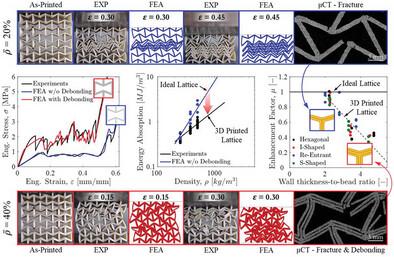Multiscale Experiments and Predictive Modeling for Failure Mitigation in Additive Manufacturing of Lattices
引用次数: 0
Abstract
Additive Manufacturing (AM) empowers the creation of high‐performance cellular materials, underscoring the increasing need for programmable and predictable energy absorption capabilities. This study evaluates the impact of a precisely tuned fused filament fabrication (FFF) process on the energy absorption and failure characteristics of 2D‐thermoplastic lattice materials through multiscale experiments and predictive modeling. Macroscale in‐plane compression testing of both thick‐ and thin‐walled lattices, along with their µ‐CT imaging, reveal relative density‐dependent damage mechanisms and failure modes, prompting the development of a robust predictive modeling framework to capture process‐induced performance variation and damage. For lower relative density lattices, an FE model based on the extended Drucker–Prager material model, incorporating Bridgman's correction with crazing failure criteria, accurately captures the crushing response. As lattice density increases, interfacial damage along bead‐bead interfaces becomes predominant, necessitating the enrichment of the model with a microscale cohesive zone model to capture interfacial debonding. The predictive modeling introduces an enhancement factor, offering a straightforward method to assess the impact of the AM process on energy absorption performance, thereby facilitating the inverse design of FFF‐printed lattices. This approach provides a critical evaluation of how FFF processes can be optimized to achieve the highest attainable performance and mitigate failures in architected materials.

多尺度实验和预测建模用于网格增材制造中的故障缓解
增材制造(AM)技术有助于制造高性能的蜂窝材料,强调了对可编程和可预测能量吸收能力的日益增长的需求。本研究通过多尺度实验和预测建模,评估了精确调整的熔融长丝制造(FFF)工艺对二维热塑晶格材料的能量吸收和失效特性的影响。厚壁和薄壁晶格的宏观面内压缩测试及其 µ-CT 成像揭示了与相对密度相关的损坏机制和失效模式,从而促使开发出一种稳健的预测建模框架,以捕捉工艺引起的性能变化和损坏。对于相对密度较低的晶格,基于扩展德鲁克-普拉格材料模型的有限元模型结合布里奇曼校正和裂纹失效标准,可以准确捕捉破碎响应。随着晶格密度的增加,珠粒-珠粒界面上的界面破坏成为主要现象,因此有必要使用微尺度内聚区模型来丰富模型,以捕捉界面脱粘现象。预测模型引入了一个增强因子,提供了一种直接的方法来评估 AM 工艺对能量吸收性能的影响,从而促进了 FFF 印刷晶格的逆向设计。这种方法对如何优化 FFF 工艺以实现最高性能和减少架构材料的失效进行了重要评估。
本文章由计算机程序翻译,如有差异,请以英文原文为准。
求助全文
约1分钟内获得全文
求助全文

 求助内容:
求助内容: 应助结果提醒方式:
应助结果提醒方式:


